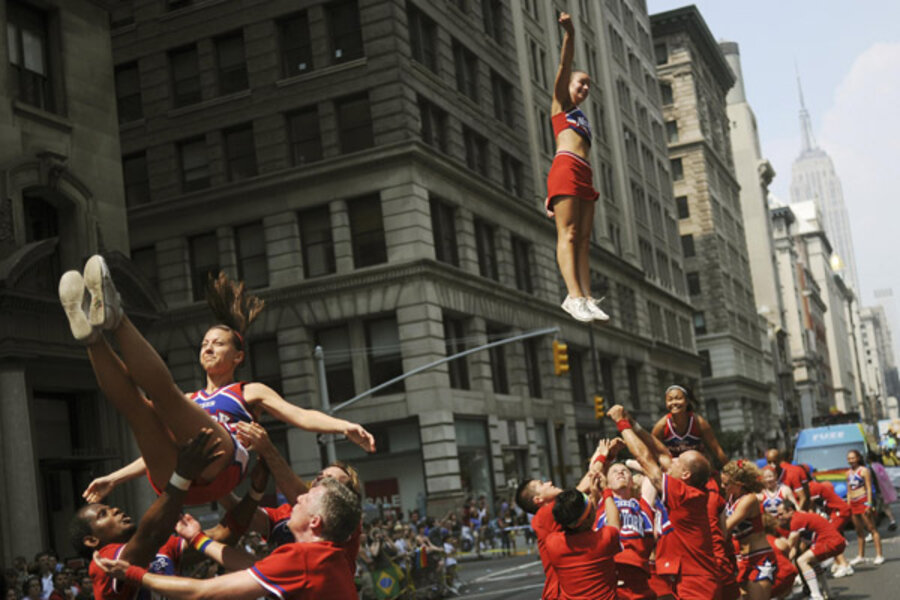Cheerleading may not be a sport, but it is an industry
Loading...
Traditional cheerleading is not an official sport, a federal judge in Connecticut ruled Wednesday, saying that Quinnipiac University’s cheer team did not meet Title IX gender-equity requirements and ordering it to reinstate its women’s volleyball squad.
But if cheerleading isn’t a sport by the judge’s standards, it is undoubtedly a robust industry.
About 3.7 million youths participate in cheer nationwide, either through community and school squads or private cheer gyms, according to estimates from Varsity, the biggest provider of cheerleading products and services in the industry. And while for many cheerleading is a relatively inexpensive afterschool activity, other families spend big—on private competitions, training, equipment, and camps.
RELATED STORY: Cheerleading doesn't count as a real sport, judge rules
“There is such a wide, wide range within cheerleading,” says Jim Lord, executive director of the American Association of Cheerleading Coaches and Administrators. “It can be done very inexpensively, or very expensively.”
Joining a competitive cheer gym costs around $2,000 to $3,000 per year, depending on how much the gym’s squads travel for competitions, according to the USA All Star Federation, which certifies cheer gyms and runs cheer competitions. Week-long overnight cheer camps can cost between $200 and $300.
And, of course, there are uniforms ($50), customized warm-ups ($45), poms ($15), and hair ribbons ($4) to be bought.
As the competitive aspect of cheerleading has grown, so have the opportunities that it offers.
“One of the things that happens in cheerleading is because of Title IX there has been more of a need to bring male and female participation in balance,” says Allen Sanderson, a professor of economics who teaches sports economics at the University of Chicago. “That has to be offset somewhere, so in terms of scholarships, some institutions have said ‘Ah, what if we have a cheerleading squad?’ ”
Many universities with big sports programs offer full scholarships for cheerleading, and dozens of smaller universities offer stipends or partial scholarships.
“Those colleges see a value in cheer programs,” says Mr. Lord. “The atmosphere they bring to games, and the role they play in alumni functions and representing the university.”
Professor Sanderson couldn’t say how Wednesday’s decision could impact funding for collegiate cheerleading in the long term. And, for the large part, neither can the cheer industry: Competitive cheer is still relatively new, and, in many ways still undefined.
But industry leaders are trying to change that, hoping to create a new sport based on traditional cheer routines that would meet Title IX requirements. These new cheerleaders wouldn't root on the sidelines – they would compete solely on their own, as some half a million competitive youth cheerleaders do now.
"We think there are ways to make some changes and some tweaks to what exists right now to create more opportunities, scholarship opportunities, for girls and young women," says John Newby, executive vice president for Varsity.
Right now, some college cheer squads fall under the purview of athletic departments, receiving scholarship and travel money, while others fall under the student activities umbrella, and have to fundraise to meet expenses.
Beyond college, there are some economic opportunities in cheer. Coaches and trainers at camps, gyms, and schools can earn stipends to augment incomes. Full-time coaches do exist and can earn up to $30,000 a year teaching in camps and big gyms and traveling to coach teams.
Or, of course, you could go pro. But don’t except to make much as a professional NFL or NBA cheerleader – many of the squads are composed of volunteers, or get paid $50 to $100 per game. And don't expect to get much respect from the competitive cheer community – professional cheerleaders are seen more as dancers by cheer squads, as they don't incorporate huge tosses and athletic tumbling into their routines.
For aspiring performers though, they do offer exposure – Paula Abdul started her career as a Lakers Girl.
The biggest business benefits that cheer aficionados point to are the interpersonal skills one must master to be a good cheerleader, like being able to perform comfortably in front of a crowd, work cooperatively, meet challenges, and set goals.
They might have a point. Some high school cheerleaders, after all, have made it pretty far – reading America the nightly news (Katie Couric) and leading the free world (yep, that would be George W. Bush).
RELATED STORY: Cheerleading doesn't count as a real sport, judge rules





